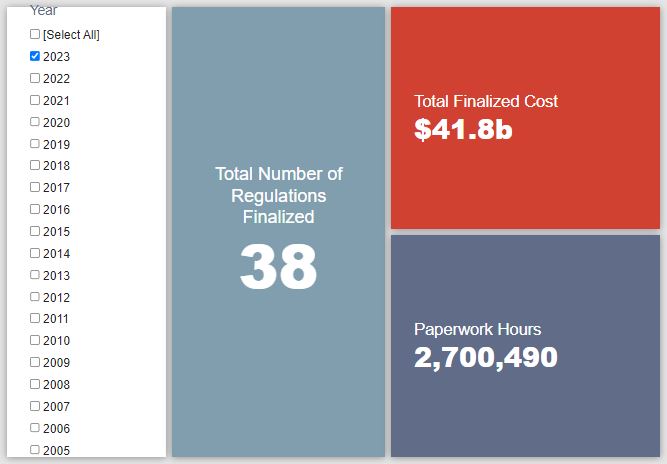Week in Regulation
March 13, 2023
An Active Week for SEC and FDA
Last week there were nine rulemakings with some measurable economic impact, most of which had a relatively modest overall effect. There was, however, a series of rulemakings from the Security and Exchange Commission (SEC) and the Food and Drug Administration (FDA) that really stood out. Across all rulemakings, agencies published $1.4 billion in total costs and added 3.7 million annual paperwork burden hours.
REGULATORY TOPLINES
- Proposed Rules: 50
- Final Rules: 72
- 2023 Total Pages: 15,239
- 2023 Final Rule Costs: $41.8 billion
- 2023 Proposed Rule Costs: $32.4 billion
NOTABLE REGULATORY ACTIONS
The most consequential rulemaking of the week, from a cost perspective at least, was the proposed rule from SEC regarding “Safeguarding Advisory Client Assets.” The proposal seeks to expand the scope of the regulations involved in the “custodial practices of advisers.” Essentially, this area of securities regulation involves the protocol that relevant investment advisors must follow when they assume “‘custody’ ( i.e., physical possession) of client funds and securities.”
According to SEC, this action is necessary since it has not updated such regulatory provisions in roughly 13 years and, in the intervening years, there have been developments such as the proliferation of crypto investments that “create new and different ways for client assets to be placed at risk of loss, theft, misuse, or misappropriation that may not be fully addressed under the current rule.” This expansion in regulatory coverage will, of course, involve more entities being required to report their actions to the Commission. SEC estimates that this will add up to nearly 600,000 hours of paperwork with $235 million in commensurate costs annually (or $705 million total over the three-year period in which paperwork requirements are approved).
A pair of rulemakings from FDA also contained significant potential economic effects, albeit in rather divergent areas. These actions included a final rule involving the “Mammography Quality Standards Act,” and a proposed rule regarding “Requirements for Tobacco Product Manufacturing Practice.” The former seeks to update regulatory provisions related to the titular law (enacted in 1992) “to modernize the regulations by incorporating current science and mammography best practices.” The latter would “set forth the requirements with which finished and bulk tobacco product manufacturers must comply in the manufacture, preproduction design validation, packing, and storage of finished and bulk tobacco products.” Together, the actions account for roughly $633 million in costs (over a 10-year window) and 3.2 million hours of paperwork.
TRACKING THE ADMINISTRATIONS
As we have already seen from executive orders and memos, the Biden Administration will surely provide plenty of contrasts with the Trump Administration on the regulatory front. And while there is a general expectation that the current administration will seek to broadly restore Obama-esque regulatory actions, there will also be areas where it charts its own course. Since the AAF RegRodeo data extend back to 2005, it is possible to provide weekly updates on how the top-level trends of President Biden’s regulatory record track with those of his two most recent predecessors. The following table provides the cumulative totals of final rules containing some quantified economic impact from each administration through this point in their respective terms.
![]()
Overall, the Biden Administration’s final rule costs and paperwork increased by roughly $471 million and 1.2 million hours, respectively. The mammography quality rule discussed above accounted for most of that upward shift. The other two administrations saw modest changes in their cost totals, although in opposite directions. A deregulatory Department of Transportation measure led to a net reduction in costs of $124 million for the Trump Administration. Meanwhile, a Department of Housing and Urban Development rule provided the bulk of a $135 million increase in Obama-era costs.
THIS WEEK’S REGULATORY PICTURE
This week, the winding regulatory river that is “Waters of the United States” (WOTUS) took yet another turn.

Source: Photo by Bryan Hanson on Unsplash
Loyal followers of AAF’s Congressional Review Act (CRA) Tracker may have noticed a slight update late last week. Last Thursday, by a vote of 227-198, the House of Representatives passed a “joint resolution of disapproval” under the CRA that seeks to rescind a rule promulgated jointly by the Environmental Protection Agency and Army Corps of Engineers in January that would largely restore the criteria of what constitutes WOTUS to a pre-2015 framework. Further details of the rule in question can be found here. This House vote marks yet another interesting turn in not only the regulatory history of WOTUS, but also the CRA as well.
The House vote comes on the heels of the Senate voting to advance – primarily due to two Democratic senators voting in the affirmative – a CRA resolution targeting a Department of Labor rule involving “environmental, social and governance (ESG) factors” in retirement plans. Given that that rule stems from a Biden Executive Order, the expectation is that President Biden will issue the first veto of his administration.
This current WOTUS rule resolution faces a similar fate if it also advances through the Senate. While it is, of course, in Democratic control, there is reason to believe that the upper chamber may make Biden pull out that veto pen a second time. Consider, for instance, that the House vote included nine Democratic yeas. Additionally, the CRA resolution targeting the 2015 Obama WOTUS rule passed the Senate with bipartisan support – including that of Senator Joe Manchin, one of the votes that also helped to advance the recent ESG rule resolution. Given the Democrats’ narrow majority, it would likely only take one more affirmative vote on that side of the aisle to advance the WOTUS resolution.
As noted above, this resolution still faces a death by veto, thus negating any real substantive policy change. This development could, however, contribute to an interesting historical record though. Of the 12 vetoes President Obama issued, five of them were for CRA resolutions. So far in the 118th Congress, there are already CRA resolutions targeting seven rulemakings – and more are almost certainly forthcoming, especially from the Republican-led House. While it is doubtful that all will advance to President Biden’s desk, having two already get there leaves open the possibility that Biden could match that Obama total.
TOTAL BURDENS
Since January 1, the federal government has published $74.2 billion in total net costs (with $41.8 billion in new costs from finalized rules) and 10.2 million hours of net annual paperwork burden increases (with 2.7 million hours in increases from final rules).











